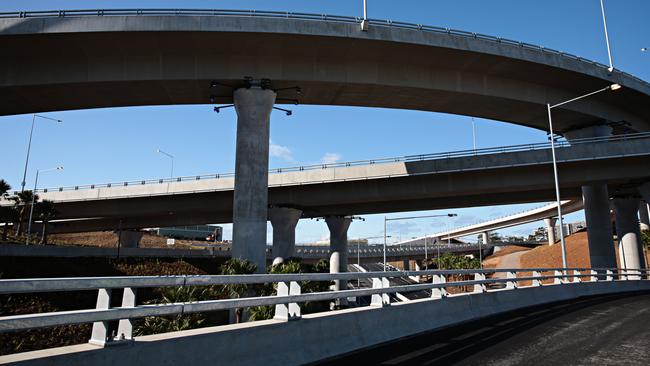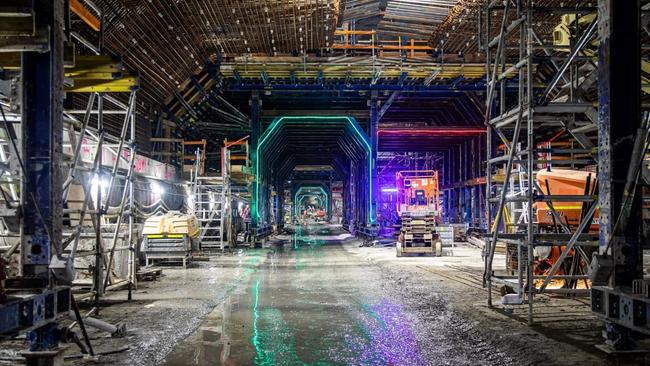Behind the ‘single focus’ that drives Transurban’s Charlton
The looming exit of Scott Charlton, who has turned Transurban into a global toll road power, shouldn’t mean it will be left at the crossroads.

Business
Don't miss out on the headlines from Business. Followed categories will be added to My News.
Transurban’s Scott Charlton likes to point out nearly everything in infrastructure can be slow moving, that’s why he is given a long lead time for his exit from the toll road operator after more than a decade in the role.
Charlton will step down when a new CEO is in place, likely at the end of this year. But for Charlton there is still a lot to do from potentially buying a stake in EastLink, a toll road in Melbourne’s east while working with other construction and state governments so they know an orderly transition is underway.
The job for appointing the next chief executive goes to new Transurban chairman Craig Drummond – the methodical former banker turned health insurance boss who on Tuesday flagged an international search as well as internal options for a replacement.
Charlton wouldn’t be drawn on the search but says there are “really strong” internal candidates also in place.
Charlton’s retirement was expected this year, although the need to launch an international search caught some by surprise. Transurban’s NSW boss and one time PwC executive Andrew Head and former investment banker turned chief financial officer Michelle Jablko are the two names widely seen as leading the internal race.

Despite investor nerves, Charlton’s looming exit doesn’t leave the $40bn Transurban at the crossroads. Far from it. The bearded Texan has built a foundation that offers shareholders long term returns and is likely to be in motorists lives for many years to come.
A new CEO simply needs to keep the pipeline of growth opportunities well stocked to replace existing toll road concessions as they mature while smoothing out the path of debt repayments. Charlton points out the average life of the company’s assets (when the concession expires) is nearly 30 years. That’s the same lifespan when he took charge more than a decade ago.
Charlton a former Lend Lease executive, says in an interview there is “no change” in strategy the has been built around Transurban.
Indeed it is through this strategy that Charlton has fundamentally transformed Transurban from what was once a collection of scattered toll roads that operated individually into the largest pure-play toll road owner in the world.
Today it is more like a Macquarie-style infrastructure play developing, operating and providing a co-investment platform for big superannuation funds looking to take direct stakes in its roads. On Tuesday Transurban outlined the latest deal selling a stake in Montreal-based toll road A25 to Canadian fund CDPQ, paving the way for more joint investment deals between the two.
Charlton likens Transurban like an industrial company such as a miner that has the means to grow internally from its existing assets while being able to capitalise on acquisitions or greenfield developments as they arise. This is the key to extending the life span of the business. Throw in customer technology and forecasting around roads and Charlton says there is a strong clear proposition in Transurban.

“We try to focus on just that and do it well and not get distracted by anything else,” Charlton says in an interview.
Charlton’s planned exit came as he delivered a strong jump in Transurban’s first half earnings to $1.24bn while revenue hit expectations of $1.73bn. A lift in traffic volumes including a record 200,000 on a single day this month on Sydney’s M4 has boosted confidence for Transurban to boost full year distributions to 57 cents a share, up from 53 cents it was guiding in December.
And the long term returns and predictability of income means investors love Transurban. It is the go to stock during periods of high inflation and still generates income during economic downturns.
Over the decade Charlton and his team have spent a lot of time working with state governments so Transurban can be seen as a partner in helping to solve traffic problems across their cities. This has seen Transurban pitch its own projects from the nine kilometre NorthConnex in Sydney to Melbourne’s mega West Gate Tunnel project – although that $10bn project has had more than its share of cost blowouts. Just last month Transurban opened the blockbuster M4 to M8 tunnel in Sydney designed to shuttle commuters to the airport.
Charlton says he has been working hard to show drivers there is value in using his roads, be it safety of time savings.
With nearly 70 per cent of revenue directly linked to inflation the most recent revenue reset stung a little more this year with prices rising on average of 6 per cent in Sydney and Brisbane. Charlton points the rate hikes are less than other price rises that consumers are facing. The roads have seen higher traffic numbers even after the increase, he adds.
“We understand it’s an issue. But the main thing is people still see value in the time savings”.
For now there are still plenty of opportunities available for Transurban to expand in Australia, even as existing roads start to mature, he says. At the same time, the US and Canada offer a big market for Transurban to expand its footprint.
“There’s no shortage of opportunities, which is a real privilege. We are lucky compared to some other industries that are struggling for growth opportunities. Our issue is just to make sure that we’re disciplined in how we approach growth”.
johnstone@theaustralian.com.au
Originally published as Behind the ‘single focus’ that drives Transurban’s Charlton



